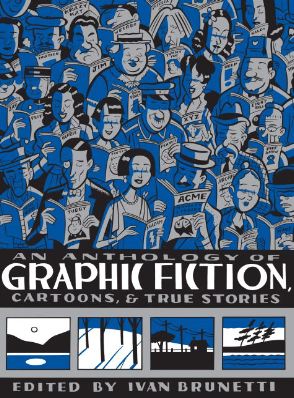
What
we have in this anthology is an attempt by Brunetti to
forge a (OK,
well, his) comics
canon where it is the form itself that is always at
the heart of the
work represented. The work we find here --
while, of course, being
comics -- is also, at some level, telling us something
about
comics, and this latter value-added feature can be
attributed in no
small part to Brunetti's editorial approach in
assembling this work,
which he clearly views as an organic whole. Each
artist
represented in this collection has a distinct and
original approach to
the medium that embodies their personal interaction
with the comics
form as well
as -- and this is where this anthology is unique --
with each other
piece in the book. This book is organized around
the principal
of association. The pieces are grouped in
clusters that are
related in a
wide variety of ways, from the form and content of the
work to the
geographic region and ethnicity of the creators.
Brunetti tips
his hand right at the outset by starting with the raw,
unbridled,
free-associative works of Marc Bell, Sam Henderson,
Mark Newgarden,
Kaz, Tony Millionaire and Bill Griffith (who all, with
the exception of
Bell, have NYC connections as well). This
approach yields many
surprising and unexpected connections as well as much
that that
proceeds in due course.
This is the
perfect
book to share with those poor lost souls who still
feel compelled to
look down their noses at comics due to childhood
brainwashing or simple
lack of exposure. The fact that it is published
by no less than
Yale University -- the alma mater of the last 3
presidents --
should cause them to at least open their eyes a
bit, at which
point we feel confident that the material contained
herein will shine a
light into the dark, comics-snubbing corner of their
being and
illuminate their ignorance,
and thereby
open them to the potential of a nourishing, life-long
relationship with
the power and wonder of comics.
Here's the Brunetti
Pantheon (in
alphabetical order, natch'):
- Robert Armstrong
- Peter Bagge
- Lynda Barry
- Gabrielle Bell
- Marc Bell
- Jonathan Bennett
- Mark Beyer
- Mart Brinkman
- Chester Brown
- Jeffrey Brown
- Ivan Brunetti
- Charles Burns
- Daniel Clowes
- David Collier
- Robert Crumb
- Henry Darger
- Gene Deitch
- Julie Doucet
- Michael Dougan
- Debbie Drechsler
- Lyonel Feininger
- Phoebe Gloeckner
- Justin Green
- Bill Griffith
- John Hankiewicz
- Sammy Harkham
- Rory Hayes
- David Heatley
- Saml Henderson
- Gilbert Hernandez
- Jaime Hernandez
- George Herriman
- Walt Holcombe
- Kevin Huizenga
- Crockett Johnson
- J. Bradley Johnson
- Ben Katchor
- Kaz
- Frank King
- James Kochalka
- Aline Kominsky-Crumb
- Harvey Kurtzman
- Jason Lutes
- Frans Masereel
- Joe Matt
- David Mazzucchelli
- Richard McGuire
- Tony Millionaire
- Jerry Moriarty
- Mark Newgarden
- Onsmith
- Gary Panter
- Harvey Pekar
- Joihn Porcellino
- Archer Prewitt
- Daniel Raeburn
- Ron Regé, Jr.
- Joe Sacco
- Richard Sala
- Charles M Schulz
- Seth
- R. Sikoryak
- Otto Soglow
- Art Spiegelman
- Cliff Sterrett
- James Sturm
- Adrian Tomine
- Carol Tyler
- Chris Ware
- Lauren R. Weinstsin
- Wayne White
- Karl Wirsum
- Jim Woodring
- Terry Zwigoff
Whew!
That's
quite a list.
It's
worth pointing out that Schulz's contribution is his
1959 essay, "How
to Develop a Comic Strip," that was originally
published by Art
Instruction, Inc. And, no, Daniel Raeburn isn't
a comics artist
in his other identity (although, then again, maybe he
is...): his
contribution is an excerpt of his essay on Clowes that
constitutes The
Imp No.1, and it provides a fitting close to
this anthology.
400 p., 7 3/8 x 10
ISBN: 0300111703
ISBN-13: 978-0-300-11170-5
embossed cloth cover w/swell wraparound DJ by Seth
retail price - $28.00
copacetic
price
- $25.00
 Anthology
of
Graphic
Fiction, Cartoons, and True Stories: Volume
Two
Anthology
of
Graphic
Fiction, Cartoons, and True Stories: Volume
Twoprices and
availability
current as of 20 October 2011